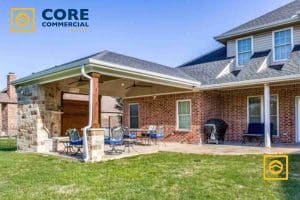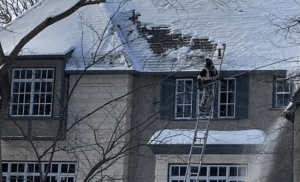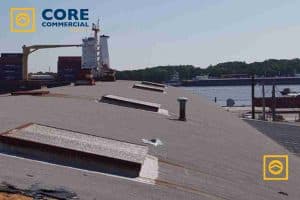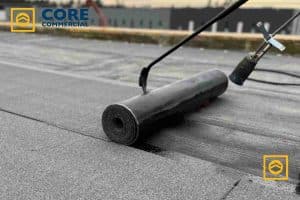Extreme weather is unforgiving, and your commercial roof is often the first to take the hit. Blistering heat can push roofing materials to their limits, while sudden hailstorms can leave lasting damage in minutes. Over time, this stress weakens your roof and leads to higher repair bills, business disruptions, and reduced property value. One of the most effective solutions we’ve seen is applying protective roof coatings. They work like sunscreen for your roof, shielding it from UV rays, sealing small cracks, and extending its lifespan.
But coatings are just one piece of the puzzle. By combining smart materials, proper drainage, insulation, and consistent maintenance, you can keep your roof strong through hot summers and storm seasons. In this article, we’ll explore seven proven methods that can save money, prevent damage, and give your property long-lasting protection.
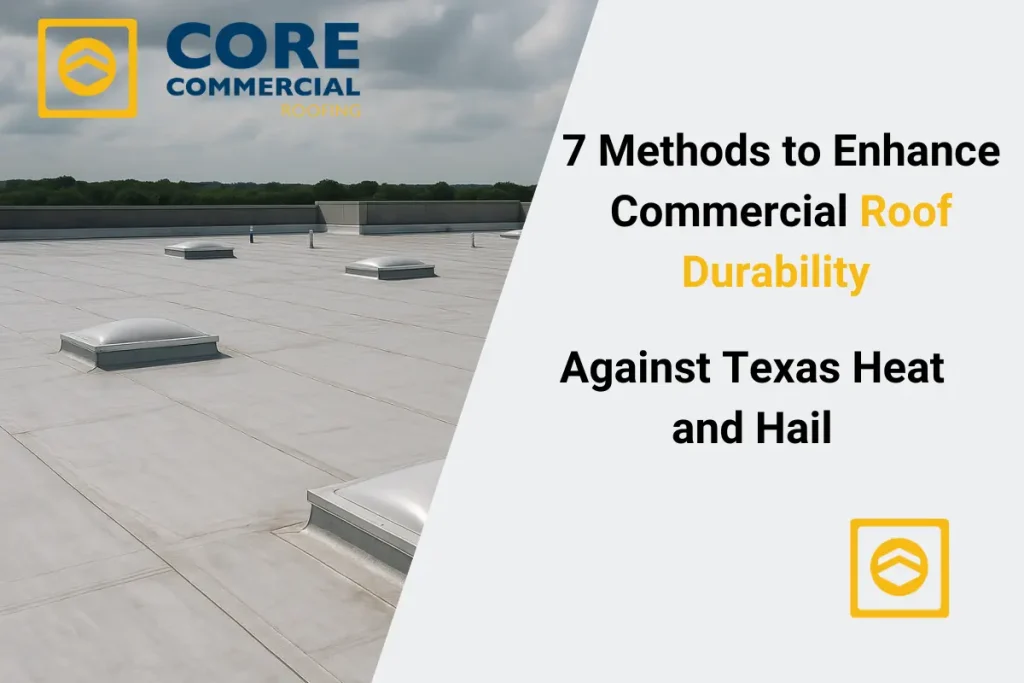
Table of Contents
1. Choose Heat-Reflective Roofing Materials
Why It Matters
The sun doesn’t just warm your building, it punishes your roof every day. Traditional dark roofing materials absorb sunlight, heating the building underneath and straining both the roof and your cooling systems. Over time, this constant exposure leads to warping, cracking, and premature roof failure.
What You Can Do
Consider installing cool roofing materials designed to reflect sunlight rather than absorb it. Options include white TPO membranes, reflective coatings, or light-colored single-ply systems. These surfaces remain cooler even when outside temperatures soar above 100°F.
Benefits for You
- Keeps indoor spaces more comfortable with less reliance on air conditioning
- Cuts energy costs by reducing cooling demand
- Extends roof life by slowing down heat-related wear
Real Results
Businesses that switch to reflective roofing often save up to 20% on cooling bills and enjoy 5–10 years longer roof life compared to traditional systems.
2. Install Impact-Resistant Shingles or Membranes
Why It Matters
Hailstorms can arrive suddenly and leave behind costly damage. Even moderate-sized hail can puncture or crack a roof, creating leaks and long-term issues.
What You Can Do
Choose Class 4 impact-rated materials that are tested to resist hail damage, such as:
- Impact-resistant asphalt shingles
- Reinforced single-ply membranes
- Modified bitumen with extra reinforcement layers
These materials are designed to absorb energy from hail without breaking.
Benefits for You
- Protects your building from sudden leaks
- Reduces emergency repair needs after storms
- May qualify you for lower insurance premiums
Real Results
Many businesses with impact-resistant roofs report fewer post-storm repairs and reduced long-term costs.

3. Improve Roof Insulation for Year-Round Protection
Why It Matters
Insulation stabilizes roof temperatures, preventing the expansion and contraction that often causes roofing materials to weaken over time. Poor insulation allows heat to transfer freely, increasing energy costs and causing hidden moisture issues.
What You Can Do
Upgrade to high R-value insulation boards such as polyisocyanurate or extruded polystyrene. These materials improve thermal resistance, reduce temperature fluctuations, and prevent stress on your roof’s structure. Adding tapered insulation can also help redirect water toward drains.
Benefits for You
- Keeps interior spaces stable and comfortable
- Prevents premature roof wear caused by temperature swings
- Reduces the risk of moisture buildup that leads to mold or rot
4. Apply Protective Roof Coatings
Why It Matters
Roof coatings act like a flexible shield. They protect against UV rays, seal minor cracks, and create a waterproof barrier. In regions with harsh sun and storms, coatings add an extra layer of resilience that significantly extends roof life.
What You Can Do
Apply an elastomeric roof coating, such as silicone or acrylic. These coatings expand and contract with weather changes, making them ideal for extreme conditions. They can be applied over metal, built-up roofing, or TPO membranes.
Benefits for You
- Adds 10+ years of life to your roof
- Reduces heat absorption and lowers cooling costs
- Postpones expensive tear-offs and replacements
Real Results
Commercial buildings that use coatings often see dramatic cost savings over time, both in reduced energy bills and fewer major repairs
5. Enhance Roof Drainage to Prevent Water Damage
Why It Matters
Heavy rainstorms can overwhelm a roof if water isn’t directed away quickly. Standing water weakens materials, seeps into seams, and encourages mold growth.
What You Can Do
- Ensure your roof has a slope-to-drain system
- Upgrade or install internal drains, scuppers, and downspouts
- Use tapered insulation to promote water flow
- Schedule routine cleanings to keep drains clear of debris
Benefits for You
- Prevents leaks and costly water damage
- Reduces stress on roofing membranes
- Increases overall roof lifespan
6. Schedule Regular Roof Inspections and Maintenance
Why It Matters
The easiest way to avoid a roofing disaster is to catch small issues before they grow. A loose seam or cracked flashing may seem minor, but under intense heat or hail, it can quickly turn into major water damage.
What You Can Do
Set up a semi-annual inspection schedule, ideally in spring and fall. During each inspection, check:
- Seals around vents, skylights, and HVAC units
- Flashing and seams for cracks
- Drainage systems for blockages
Benefits for You
- Prevents 80% of major roofing issues
- Lowers repair costs by fixing problems early
- Provides peace of mind before storm season
7. Invest in Roof Reinforcement Systems
Why It Matters
Older roofs may not be built to handle today’s severe climate. Reinforcement adds extra durability, giving your roof a stronger defense against heat, hail, and wind.
What You Can Do
- Install a secondary waterproofing layer
- Upgrade to a ballasted or mechanically attached roof system
- Add structural fasteners or insulated panels to metal roofs
Benefits for You
- Strengthens the roof against extreme weather
- Improves energy performance
- Extends long-term property value
Bonus Tips: Go Beyond the Basics
If you want to give your roof even more staying power, consider these additional strategies:
- Keep a roof logbook with inspection dates and photos to track wear
- Trim trees near the roof to avoid punctures from falling branches
- Train staff to report leaks or ceiling stains immediately
- Use drones or sensors for advanced inspections on large facilities
Why This Matters to You
Every business owner knows that roofing problems are expensive and disruptive. Prevention is always cheaper than emergency repair. By applying these seven methods, you’ll:
- Lower repair and energy bills
- Avoid unplanned downtime caused by leaks
- Protect your investment and property value
- Gain peace of mind when the next storm rolls through
Summary Checklist: What to Do Next
| Step | Action | Benefit |
| 1 | Switch to heat-reflective roofing | Reduce heat damage and energy costs |
| 2 | Install impact-resistant materials | Prevent hail damage |
| 3 | Upgrade insulation | Improve energy control and reduce stress |
| 4 | Apply protective coatings | Extend roof life and improve efficiency |
| 5 | Improve drainage | Stop water pooling and leaks |
| 6 | Schedule inspections | Catch issues early |
| 7 | Reinforce roof | Strengthen durability for long term |
Final Thoughts
Your commercial roof is more than just a covering; it’s your first defense against harsh weather. Extreme heat and sudden hailstorms will always be part of the environment, but your response determines whether your roof survives or fails. By using reflective materials, installing impact-resistant systems, applying coatings, and staying consistent with maintenance, you’re making smart, cost-effective choices that extend roof life and safeguard your business.
When your roof lasts longer, your business runs stronger. These methods aren’t luxuries. They’re essential steps that pay for themselves through lower bills, fewer repairs, and greater confidence year-round.
FAQs
How to protect a commercial roof from Texas hail damage?
In Texas hail zones, use Class 4 or FM 4470 impact-rated roofing membranes and hail guards on rooftop units. Add regular inspections after storms and apply protective coatings. This shields your roof and lowers repair risk.
Best roof coating for Texas heat and UV?
Use white or silicone elastomeric coatings designed for cool roofs. These reflect sun and protect against UV, which reduces heat stress on roofing and HVAC. They can extend roof life significantly.
Should I inspect the roof after hail hailstorm in Texas?
Yes. Inspect within 48 hours after hail to catch dents, membrane punctures, or granule loss. Quick checks help avoid hidden damage and preserve insurance claims.
How often should inspect commercial roof be inspected in Texas?
Inspect twice a year—in spring and fall—and within days of severe storms. That way you catch leaks early, especially before heat or hail seasons.
How to improve roof drainage on a flat Texas roof?
Add tapered insulation or ensure drains, scuppers, and downspouts are clear and sloped. Good drainage prevents water pooling that damages the roof.
Is cool roofing worth it in commercial Texas?
Yes. Reflective roofs using cool roofing materials like TPO or coatings cut roof surface heat, lower energy bills, and reduce roofing wear from heat.
What hail size damages a Texas commercial roof?
In Texas, hail over 1 inch can harm older roofing and flashings; hail around 1.5 inches or larger often causes serious cracks, punctures, and granule loss.
Can hail damage be hidden on a commercial roof?
Yes—hail can crack membranes or underlayment without visible dents. Look for granules in gutters, soft spots on the roof, and inspect after storms.
When to file a commercial hail damage claim in Texas?
File within two years of the hail. But submit sooner—claims filed within weeks improve chances, document damage early, and protect insurance payout.
What materials resist Texas heat and hail?
Choose cool TPO or reflective membrane, impact-rated shingles or modified bitumen, high‑R insulation, and UV‑resistant coatings. Reinforce with hail guards & proper drainage.



